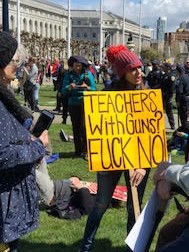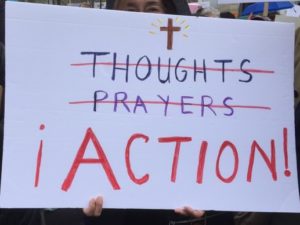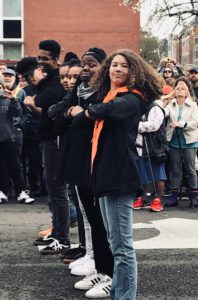
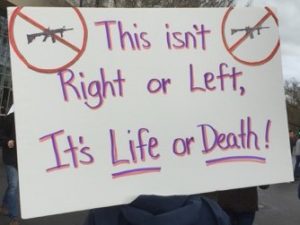
Ed: It is hard to not be moved by the events on the weekend of March 24, 2018, primarily because the eloquence came from the youth of our culture. Several of our West Coast authors were moved to contribute by sharing their experiences from several different March for our Lives events: Oakland, San Francisco, San Jose, Nevada City (CA), and Eugene (OR). Eternally young eighty-ish photographer Barry Shapiro (see “Oakland’s General Strike and the March to Close the Ports“) climbed a wall to get a better angle of the Oakland High School March for our Lives, fell, and was hospitalized for a brief period, where he was moved to pen a piece about the aesthetics of aging. Look for it in a future issue. I have included an excerpt from Barry’s 2011 article because it still seems (unfortunately) relevant today.
March for Our Lives: Mini Photo Essay
OAKLAND, CA: Barry Shapiro
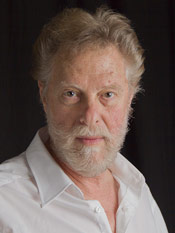
Excerpt from Barry’s 2011’s piece, “Oakland’s General Strike…”
“It seems very long ago that we activists fought with fervor and hope, believing that we could change America for the better. And indeed, in many ways we did. Our legacy of civil rights and women’s rights and programs that attempted to eliminate poverty still stand. At least in some measure. Unfortunately, in recent years, we’ve watched in horror: the wars on women, growing income inequality, the decimation of the personal/family wealth of people of color, the mortgage loan scandals, the pollution of the political process by uncontrolled and un-accountable amounts of private/corporate spending, threatening to wipe away all of our gains. Instead of hope, we began to experience despair–feeling powerless to stop the Right’s money and influence.”
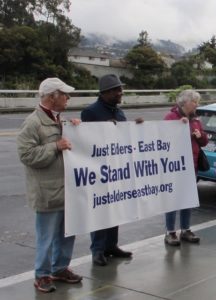
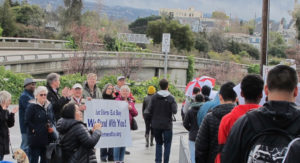
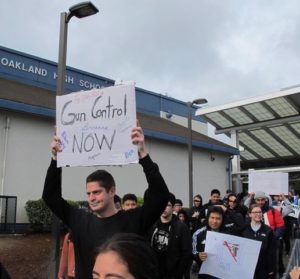
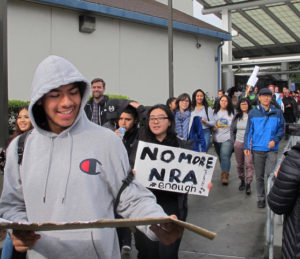
The Next Civil Rights Struggle Will be Fought by our Own Kids
NEVADA CITY, CA: Dr. Jeff Kane
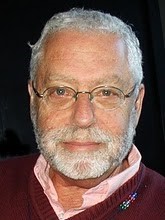
Reminiscing on the nineteen-sixties, I told my kids, “Man, did you miss an amazing decade: the Vietnam War, civil rights, emerging feminism, eco-consciousness, psychedelics…”
They replied, “Don’t worry. We’ll get our own amazing decade.”
And here it is. Our younger citizens, recognizing they’re getting short-changed, are creating a movement that will transform America as much as we gray longhairs did. Whoever thought our own kids would drive the next civil rights struggle?
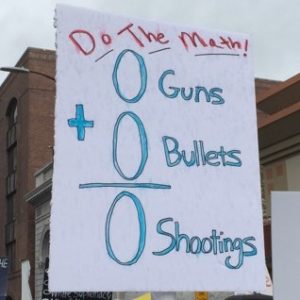
I’m writing this on March 24, the day of the national “March For Our Lives.” Young people are demanding protection from gun violence, but want more, too. They resent the environmental cesspool we’re leaving them. They want the affordable education necessary to any democracy. They want an effective voice in their future.
A society that cares about its children plans generations ahead. We haven’t. Our relative neglect of our descendants’ welfare constitutes de facto national child abuse. It’s as though we’ve told our kids, “Sure, we’ve been wasteful and thoughtless, but damn, we had a great party. Now you clean it up.” Little wonder that as they hide in school closets, many students think adults might not be right in the head.
That issue arose recently when our president proclaimed that the mass murder at Marjory Stoneman Douglas High School in Parkland, Florida, was a manifestation of poor mental health. He’s absolutely right, and far more widely than he recognizes. Poor mental health describes:
- legislators who believe “thoughts and prayers” adequately address mass murder;
- electoral tolerance of Congress members who are shamelessly on the NRA dole;
- a president who canceled a regulation that made it harder for mentally ill people to purchase guns;
- a nation that has yet to develop a no-nonsense attitude—in addition to law—that keeps firearms from those who shouldn’t have access. (Toddlers, for example: 2-4 year-olds mishandling guns have been responsible for more deaths since 9/11 than foreign terrorists);
- blind fear—of crime, of terrorism, of immigrants, of our own government. In the United States there’s one gun for every man, woman, and child. With all that weaponry, what are we so afraid of? Violent crime has actually been decreasing. As for armed defense against a tyrannical federal government—a government that’s arguably the best-armed and most ruthless in world history—consider the outcomes at Ruby Ridge, Waco, and Malheur Refuge;
- those of us willing to live permanently, literally, under the gun—thinking twice about attending a concert or going to church or a shopping mall, not to mention sending our kids to school.
Young people have seen how deficient mental health can decay morality, and not just in relation to gun violence. Why else would we adults accept stratospheric education costs, pollution-caused illnesses, perpetual wars, and the planet’s catastrophic heating?
We’re not talking about schizophrenia here, or bipolar disorder, or even disabling neurosis. We’re talking about everyday denial and delusion, and abdication of responsibility. Noticing this gross decline in standards, our kids are having none of it. Passionate and articulate, they mean to get us back on track by demanding their birthrights of life, liberty, and pursuit of happiness. And they’ll need our support.
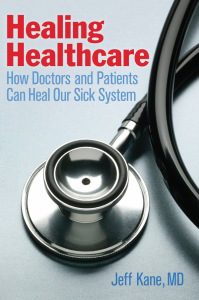
March for Our Lives: Beloved Community as Local and National
EUGENE, OREGON: Carter McKenzie
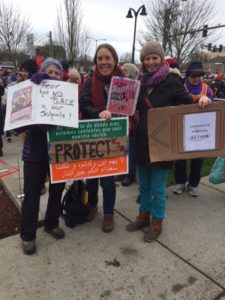
My youngest daughter was two years old at the time of the shooting at Thurston High School in Springfield, Oregon. I remembered this when listening to Betina Lynn, a survivor of that shooting, speak outside of the Federal Courthouse in Eugene at the March for Our Lives event yesterday. She courageously addressed a gathering of what became more than 6000 marchers, speaking of the ongoing trauma she has endured from the gunshots that severely wounded her and killed two of her classmates in 1998, and stating the anger she feels when yet another school shooting occurs.
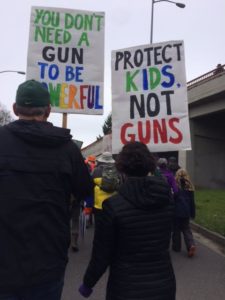
I remember carrying my daughter to a chain link fence bordering Thurston High School and laying down flowers in grief and shock days after that shooting. Yellow, late spring flowers, among many, many more flowers and messages of condolences along the fence. In memory—in incomprehension. I knew a teacher at that school. He and his family were my neighbors. This violence was not remote but affecting people in my world. Affecting how I saw threats to the future of children I knew, including my own.
None of us is free until we all are free. None of our children are safe until all of our children are safe.
Yesterday’s March for Our Lives: more than five weeks after the shooting that killed 17 people at Marjory Stoneman Douglas High School in Parkland, Florida, and two months before the 20th anniversary of the Thurston shooting. Also nearing the 3rd anniversary of the shooting at Umpqua Community College in Roseburg, Oregon. I remember that October day—the incongruous beauty of the vine maple leaves taking on colors of fire in the mountains.
Yesterday was evidence of the leadership of the youth in this country. Evidence of their vision and courage and holy rage. It was the day 11-year-old Naomi Wadler, speaking to hundreds of thousands of marchers in Washington D.C., recognized the 18th person lost to gun violence in recent weeks: Courtlin Arrington, whose death on March 7 from a school shooting at Huffman High School in Birmingham, Alabama, had not garnered central media attention.
Courtlin Arrington, a seventeen-year-old African American woman who was two months away from becoming a nursing assistant, was buried yesterday.
The march in Eugene was made possible by weeks of hard work by area high school students. Students who are beautiful, intelligent, and passionate in their energy and vision. Leaders. They made this happen: a way to declare what is not acceptable—the subjection of school communities to the threat of gun violence. They made this happen: a way to declare the necessity of freeing all communities from such violence.
Yesterday, Betina Lynn reminded us that the brave youth leading in this protest cannot do it alone—“nor should we ask them to.”
(quote in final paragraph from The Register-Guard report on March for Our Lives event in Eugene, Sunday, March 25, 2018)
Carter’s new collection of poems Stem of Us will be released by Flowstone Press, Summer 2018.
My Experience at March for Our Lives
SAN JOSE, CALIFORNIA: Martha Kendall
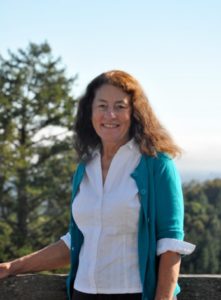
I turned the windshield wipers up to the max. The downpour couldn’t stop us. Destination? Downtown San Jose for the March for Our Lives. It rained on our parade, but that didn’t dampen our determination to end the gun violence in our country.
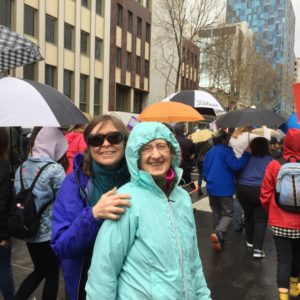
My husband and I carpooled with another couple from the Santa Cruz Mountains. Near City Hall, we met up with two additional friends: Diana, who is a long-time pal, and her octogenarian mother Ruth, visiting from her home in rural Tennessee. Ruth said, “I grew up with guns when my family lived near the woods. My brother shot squirrels and deer that added to our food supply.” But she was as disgusted as the rest of us by the slaughter Americans now inflict on each other.
Umbrellas aloft, thousands of us walked the downtown streets. Participants included adults of all ages and affiliations, teens carrying banners, and little kids in strollers. There was no shortage of pussy hats, though hoods were the practical choice to protect against the rain.
Exuberance and affirmation had set the tone for the two women’s marches I’d previously attended in San Jose. The mood on March 24 felt more somber. Signs were clever and varied, but as one said, “This isn’t Left or Right. It’s Life or Death.” Many referred to the familiar “#Enough,” but Ruth and I agreed it’s way past “enough.” One sign said, “Lives, not bribes.” The NRA was accused of having “No Real Answers.” Another sign said, “’NRA, How many spokespeople does it take to change a light bulb?’ The answer? ‘More guns.’”
After we drove home, the impact of the March for Our Lives continued. I posted a few photos on Facebook, and I was grief-stricken to read one of the responses. It came from a soft-spoken, generous innkeeper my husband and I had met a half dozen years ago in Louisiana when we were passing through on a bicycle trip. We wanted to try a Greek restaurant about five miles away, and he insisted on loaning us his car so we wouldn’t have to ride our bikes back in the dark. When we returned to the motel after a delicious dinner, he introduced us to his charming wife and friendly 20-year-old son. We had such a nice conversation that we became Facebook friends so we could keep in touch.
His comment on my Facebook post? “My son was killed by a bullet.”
The gun violence in America is sickeningly, terrifyingly abnormal. We must stop it, and the only way is with ballots, not more bullets.
SAN FRANCISCO, CALIFORNIA: Diane Perea


Most of the speakers at this event were young people, articulate and passionate. Some shared their personal experiences with gun violence.
- A high school senior from the Bayview District who, at 13 years of age, while walking her two younger sisters home from school, suddenly found herself in the midst of a shootout on the street. She spent the next several minutes on the ground, doing her best to shield her sisters from harm until the shooting stopped. To this day she suffers from PTSD, experiencing extreme fear and anxiety every time she hears a door slam or a car backfire.
- A young woman who survived the mass shooting at Columbine High School back in 1999, talked about what it was like to be crammed into a small office with 60 other students, waiting until the shooting stopped and then waiting another four hours until the S.W.A.T. team came to escort them off campus.
- A father who lost his son, a student at UC Santa Barbara, to a shooter on a rampage in Isla Vista in 2014.
- A young adolescent described what it was like for her to have to rehearse school drills (since kindergarten) on what to do in case of a shooter.
